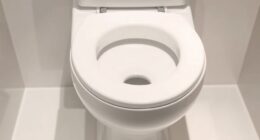Are you prepared to enhance your bathroom? This guide will walk you through the process of replacing your bathroom sink faucet, step by step. We have compiled a list of all the necessary tools and materials, so let’s get started!
First, we’ll turn off the water supply to ensure a smooth process.
Then, we’ll guide you through removing the old faucet and installing the new one.
Finally, we’ll help you test for leaks and ensure a flawless finish.

Let’s get started on your journey to faucet mastery!
Key Takeaways
- Choose the right faucet based on style, finish, and functionality.
- Gather necessary tools and materials such as wrenches, pliers, and plumber’s tape.
- Turn off the water supply by locating and closing the shut-off valves under the sink.
- Properly remove the old faucet by disconnecting the nuts or screws and lifting it out of the sink.
Gather the Necessary Tools and Materials
To begin replacing a bathroom sink faucet, we’ll need to gather the necessary tools and materials.
The first step is to choose the right faucet for your bathroom sink. Consider the style, finish, and functionality that best suits your needs.
Next, gather the tools required for the installation, such as an adjustable wrench, pliers, a basin wrench, a screwdriver, and plumber’s tape. Additionally, make sure to have a bucket or towel handy to catch any water that may spill during the process.

Proper maintenance for bathroom sink faucets is also essential to prolong their lifespan. Regularly clean the faucet with a mild soap and water solution, avoiding abrasive cleaners that can damage the finish. Check for any leaks or drips and repair them promptly to prevent further damage.
Following these steps will ensure a successful faucet replacement and a well-maintained bathroom sink.
Turn off the Water Supply
First, we need to turn off the water supply before replacing the bathroom sink faucet. This step is crucial to ensure that water doesn’t continue to flow while we work on the faucet. Turning off the water supply will prevent any accidental leaks or water damage.
To do this, locate the shut-off valves under the sink. These valves control the flow of water to the faucet. Turn them clockwise until they’re fully closed.

It’s important to regularly maintain bathroom sink faucets to prevent common issues such as leaks, low water pressure, or malfunctioning handles. Regularly cleaning the aerator, checking for any leaks, and addressing them promptly will help keep your bathroom sink faucet in good working condition.
Troubleshooting these issues will help you identify and resolve them effectively.
Remove the Old Faucet
Now that we’ve turned off the water supply, let’s move on to removing the old faucet. Here are the steps to follow:
- Start by placing a bucket or towel under the sink to catch any water that may drip during the process.
- Locate the nuts or screws that hold the faucet in place. These are usually found underneath the sink.
- Use a wrench or screwdriver to loosen and remove the nuts or screws.
- Once the nuts or screws are removed, gently lift the old faucet out of the sink.
- Properly dispose of the old faucet by recycling it if possible or taking it to a local waste disposal facility.
Now that the old faucet is removed, it’s time to choose the right replacement faucet. Consider factors such as style, finish, and functionality to find the perfect fit for your bathroom sink.

Install the New Faucet
After removing the old faucet, we can proceed to the installation of the new faucet. Proper maintenance and choosing the right faucet are crucial steps in this process. To ensure a successful installation, follow these steps:
- Start by reading the manufacturer’s instructions carefully. This will provide you with specific guidance for your particular faucet model.
- Gather all the necessary tools and materials, including a wrench, plumber’s tape, and silicone caulk.
- Position the new faucet in place, aligning the holes with the sink.
- Secure the faucet by tightening the mounting nuts underneath the sink.
- Connect the water supply lines to the corresponding valves, making sure to use plumber’s tape to prevent leaks.
- Turn on the water supply and check for any leaks. If necessary, tighten the connections further.
Test and Check for Leaks
Once we’ve installed the new faucet and connected the water supply lines, it’s important to test and check for any potential leaks. Here are the steps to follow:
- Turn on the water supply: Slowly open both the hot and cold water valves to allow water to flow through the faucet.
- Inspect for leaks: Carefully examine the connections between the faucet and the water supply lines for any signs of leaks.
- Check the base: Look for any water pooling around the base of the faucet. This could indicate a leak from the base.
- Test the handles: Turn the handles on and off to ensure they operate smoothly and don’t leak.
- Run water: Run water from the faucet at different temperatures to verify that there are no leaks or irregularities.
Regular maintenance is important to prevent leaks and ensure the longevity of your faucet. With the different types of bathroom sink faucets available in the market, it’s crucial to test for leaks after installation to avoid any potential issues.
Frequently Asked Questions
How Do I Choose the Right Bathroom Sink Faucet for My Needs?
When choosing a bathroom sink faucet, we consider factors such as desired finishes and the right size. We measure the existing faucet or the sink holes to ensure a proper fit.

What Should I Do if I Encounter a Stubborn or Rusted Faucet During the Removal Process?
When encountering a stubborn or rusted faucet, we recommend applying penetrating oil to loosen it. Use a wrench or pliers to carefully remove the faucet. Prevent future rust buildup by regularly cleaning and maintaining the faucet.
Can I Replace the Bathroom Sink Faucet Without Turning off the Main Water Supply to the House?
Yes, you can replace the bathroom sink faucet without turning off the main water supply. Here’s how: 1) Shut off the water valves under the sink. 2) Disconnect the supply lines. 3) Remove the old faucet. 4) Install the new faucet. 5) Reconnect the supply lines. 6) Turn on the water valves.
Are There Any Specific Precautions I Should Take When Installing a New Faucet to Ensure a Secure and Leak-Free Installation?
When installing a new faucet, there are specific precautions we should take to ensure a secure and leak-free installation. We need to use the appropriate tools and avoid common installation mistakes.
How Often Should I Replace the Washers or Cartridges in My Bathroom Sink Faucet to Prevent Leaks and Maintain Optimal Performance?
To prevent leaks and maintain optimal performance, we should regularly replace the washers or cartridges in our bathroom sink faucets. It’s important to know how to properly clean our faucets and recognize signs that indicate it’s time for a replacement.

Conclusion
Replacing a bathroom sink faucet is a simple and satisfying DIY project. By following the step-by-step instructions, you can easily update your bathroom’s look and functionality.
Gather the necessary tools, turn off the water supply, remove the old faucet, and install the new one.
Don’t forget to test for leaks and enjoy your newly installed faucet that brings style and function to your bathroom.
So, say goodbye to the old and hello to the new, and let your bathroom shine with a stunning sink faucet!











